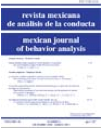Response Acquisition with Delayed Conditioned Reinforcement
Main Article Content
Abstract
The present study assessed the possibility that lever pressing by rats, will increase, if this response is correlated with the presentation of exteroceptive stimuli, previously paired with primary reinforcement. Naïve rats were exposed to ten 30 minute sessions where a FT 60-s schedule presented food correlated with a 3-s blackout and the operation of the food delivery magazine. After the training phase was over, an acquisition phase began, subjects could receive one of four different schedules for twenty consecutive sessions: 1) CRF; 2) FR1, FT 2-s; 3) FR1, FT 5-s or 4) FR1, FT 10-s; nine subjects were exposed to each schedule. Results produced by the conditioned reinforcement conditions were compared with conditions where: 1) primary reinforcement was delivered during the acquisition phase, 2) blackout and magazine operation occurred during the training phase but in the absence of food, and 3) subjects remained in the experimental chamber without any programmed stimulus presentation during the training phase. Both the primary reinforcement and the conditioned reinforcement conditions produced delay gradients; the latter was considerably steeper than the former. Results were discussed in terms of their similarity with previous studies; they were also discussed in terms of the ongoing debate regarding the empirical validity of the conditioned reinforcement concept.
Article Details
How to Cite
Sosa, R., & Pulido, M. A. (2011). Response Acquisition with Delayed Conditioned Reinforcement. Mexican Journal of Behavior Analysis, 37(2), 83–98. https://doi.org/10.5514/rmac.v37.i2.26141
